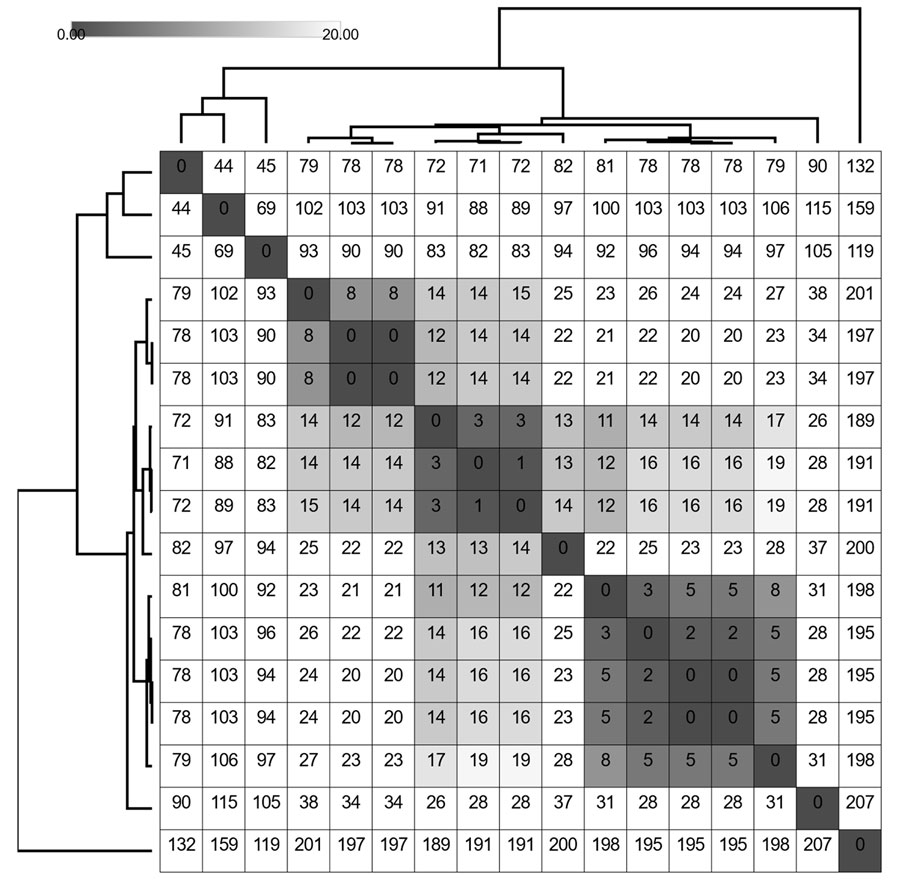Volume 31, Number 10—October 2025
Dispatch
Genomic Investigation of Disseminated Gonococcal Infections, Minnesota, USA, 2024
Figure 2

Figure 2. Pairwise single-nucleotide polymorphism (SNP) matrix of Neisseria gonorrhoeae sequence type (ST) 11184 genomes from disseminated gonococcal infection cases, Minnesota, USA. We clustered and visualized the matrix by using Morpheus (https://morpheussoftware.net) from SNPs identified within a reference-based genome alignment we generated by using the Dryad v3.0 pipeline (4), with an internal reference genome. The grayscale shading represents SNP values of 0–20. The branches represent hierarchical clustering of rows and columns of pairwise SNP calls.
References
- Marrazzo JM, Apicella MA. Neisseria gonorrhoeae (gonorrhea). In: Blaser MJ, Cohen JI, Holland SM, editors. Mandell, Douglas, and Bennett’s principles and practice of infectious diseases. Amsterdam: Elsevier; 2015. p. 2446–2462
- Cartee JC, Joseph SJ, Weston E, Pham CD, Thomas JC IV, Schlanger K, et al. Phylogenomic comparison of Neisseria gonorrhoeae causing disseminated gonococcal infections and uncomplicated gonorrhea in Georgia, United States. Open Forum Infect Dis. 2022;9:ofac247. DOIGoogle Scholar
- Wisconsin State Laboratory of Hygiene. Spriggan, 2022 [cited 2025 May 27]. https://github.com/wslh-bio/spriggan
- Wisconsin State Laboratory of Hygiene. Dryad, 2023 [cited 2025 May 27]. https://github.com/wslh-bio/dryad
- Jolley KA, Bray JE, Maiden MCJ. Open-access bacterial population genomics: BIGSdb software, the PubMLST.org website and their applications. Wellcome Open Res. 2018;3:124. DOIPubMedGoogle Scholar
- Maiden MC, Bygraves JA, Feil E, Morelli G, Russell JE, Urwin R, et al. Multilocus sequence typing: a portable approach to the identification of clones within populations of pathogenic microorganisms. Proc Natl Acad Sci U S A. 1998;95:3140–5. DOIPubMedGoogle Scholar
- Golparian D, Sánchez-Busó L, Cole M, Unemo M. Neisseria gonorrhoeae Sequence Typing for Antimicrobial Resistance (NG-STAR) clonal complexes are consistent with genomic phylogeny and provide simple nomenclature, rapid visualization and antimicrobial resistance (AMR) lineage predictions. J Antimicrob Chemother. 2021;76:940–4. DOIPubMedGoogle Scholar
- Schwengers O, Jelonek L, Dieckmann MA, Beyvers S, Blom J, Goesmann A. Bakta: rapid and standardized annotation of bacterial genomes via alignment-free sequence identification. Microb Genom. 2021;7:
000685 . DOIPubMedGoogle Scholar - Tonkin-Hill G, MacAlasdair N, Ruis C, Weimann A, Horesh G, Lees JA, et al. Producing polished prokaryotic pangenomes with the Panaroo pipeline. Genome Biol. 2020;21:180. DOIPubMedGoogle Scholar
- Minh BQ, Schmidt HA, Chernomor O, Schrempf D, Woodhams MD, von Haeseler A, et al. IQ-TREE 2: new models and efficient methods for phylogenetic interence in the genomic era. Mol Biol Evol. 2020;37:1530–4. DOIPubMedGoogle Scholar
- Sagulenko P, Puller V, Neher RA. TreeTime: maximum-likelihood phylodynamic analysis. Virus Evol. 2018;4:vex042. DOIGoogle Scholar
- Seemann T, Klotzl F, Page AJ. snp-dists. Pairwise SNP distance matrix from a FASTA sequence alignment. 2018 [cited 2025 May 27]. https://github. com/tseemann/snp-dists
- Welch G, Reed GW, Rice PA, Ram S. A meta-analysis to quantify the risk of disseminated gonococcal infection with Porin B serotype. Open Forum Infect Dis. 2024;11:ofae389. DOIGoogle Scholar
- Shaskolskiy B, Kravtsov D, Kandinov I, Gorshkova S, Kubanov A, Solomka V, et al. Comparative whole-genome analysis of Neisseria gonorrhoeae isolates revealed changes in the gonococcal genetic island and specific genes as a link to antimicrobial resistance. Front Cell Infect Microbiol. 2022;12:
831336 . DOIPubMedGoogle Scholar - Reimche JL, Clemons AA, Chivukula VL, Joseph SJ, Schmerer MW, Pham CD, et al.; Antimicrobial-Resistant Working Group. Genomic analysis of 1710 surveillance-based Neisseria gonorrhoeae isolates from the USA in 2019 identifies predominant strain types and chromosomal antimicrobial-resistance determinants. Microb Genom. 2023;9:mgen001006. DOIGoogle Scholar
Page created: August 18, 2025
Page updated: September 25, 2025
Page reviewed: September 25, 2025
The conclusions, findings, and opinions expressed by authors contributing to this journal do not necessarily reflect the official position of the U.S. Department of Health and Human Services, the Public Health Service, the Centers for Disease Control and Prevention, or the authors' affiliated institutions. Use of trade names is for identification only and does not imply endorsement by any of the groups named above.